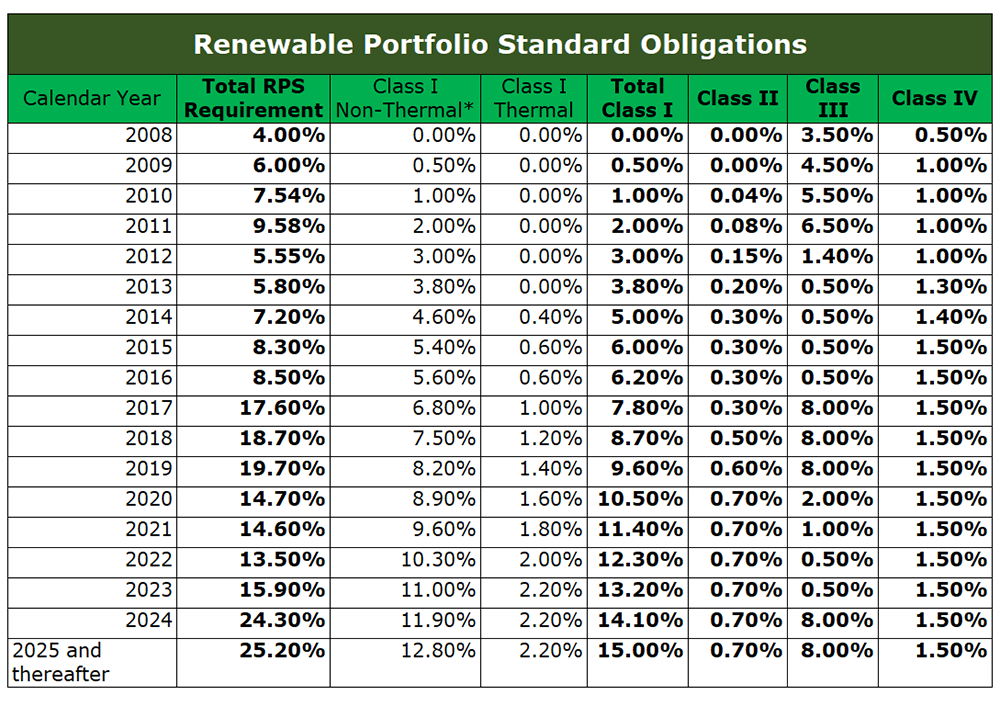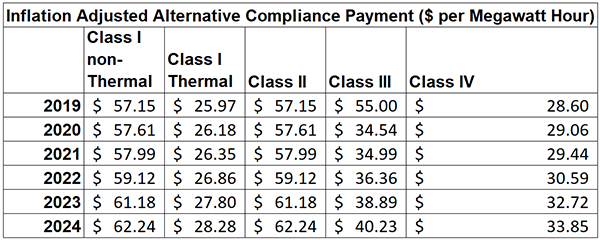Renewable Portfolio Standard
New Hampshire's Renewable Portfolio Standard (RPS) statute, RSA 362-F, enacted in 2007, establishes the State’s renewable energy policy.
SIGN UP FOR RPS AND 2500 RULE NOTIFICATIONS
Use the sign-up page to receive notifications on the Renewable Portfolio Standard/N.H. Admin 2500 Rules
New Hampshire's RPS statute, RSA 362-F, requires each electricity provider to meet customer load by purchasing or acquiring certificates representing generation from renewable energy based on total megawatt-hours supplied. New Hampshire's RPS statute divides renewable energy sources into four separate classes. A summary of the eligible sources for each class is below; please see RSA 362:F for full details regarding requirements for each source.
Class I - New Renewable Energy. Sources producing electricity or "useful thermal energy" (i.e., Class I Thermal) generated by any of the following resources, provided the generator began operation after January 1, 2006, except as noted below:
- Wind energy;
- Hydrogen derived from biomass fuels or methane gas;
- Ocean thermal, wave, current, or tidal energy;
- Methane gas;
- Eligible biomass fuels (including the biomass share of certain generators co-fired with fossil fuels);
- Solar-electric energy not used to satisfy the minimum Class II obligation;
- The incremental new production of electricity in any year from an eligible biomass, eligible methane source, or hydroelectric generating facility of any capacity, over its historical generation baseline;
- The production of electricity from Class III or IV sources that have been restored through significant investment.
Class I Thermal – Useful Thermal Energy. Class I Thermal resources must be used to meet a set percentage of the total Class I RPS obligation as outlined in RSA 362-F:3. Eligible Class I Thermal sources include the following technologies that began operation after January 1, 2013, except as noted below:
- Geothermal systems that began producing thermal energy;
- Solar-thermal systems that produce useful thermal energy only;
- Eligible biomass generators that meet emissions criteria;
- The production of useful thermal energy from certain biomass thermal sources which began operation prior to January 1, 2013 and have been upgraded or replaced through significant investment.
For more information on the development of the Class I Thermal Renewable Energy Certificate Program.
Class II – New Solar. Solar technologies: provided the electric generator began operation after January 1, 2006.
Class III – Existing Biomass/Methane. Eligible biomass systems of 25 megawatts (MW) or less, and methane gas, provided the generator began operation before January 1, 2006. Methane gas sources which began operation prior to 2006 and exceed an aggregated gross nameplate capacity of 10 MW at any single landfill site are not eligible.
Class IV – Existing Small Hydroelectric. Hydro facilities up to 5 MW, provided the generator began operation before January 1, 2006, and complies with certain environmental protection criteria; and hydroelectric facilities up to 1 MW that are interconnected to the distribution grid in New Hampshire. Please note that the Commission has issued an Order waiving the PUC's administrative rule requiring certain Class IV facilities to have installed upstream and downstream diadromous fish passages. See Order 25,394.
The RPS requirement increases from 4% in 2008 to 25.2% in 2025 and thereafter. The RPS obligations by class and year are as follows:

* Beginning January 1, 2018, a provider of electricity may use certificates issued based on the production of biodiesel in New Hampshire to meet up to 12.5% of the provider's Non-Thermal Class I portfolio standard requirements in any given year.
**Class I thermal is a subset of Class I. The thermal requirements are subsumed in the Class I requirement and are not additional to Class I
Visit the Historical RPS Obligation Changes webpage to view legislative and commission changes to RPS obligations over time.
Under the RPS statute, electricity providers are required to generate or purchase renewable energy certificates from suppliers through the New England Power Pool Generation Information System (NEPOOL-GIS). A renewable energy certificate represents 1 megawatt-hour of electricity produced from eligible renewable energy sources and may be sold separately from the associated electricity.
If the electricity providers are not able to meet the RPS requirements by purchasing or acquiring renewable energy certificates, they must pay alternative compliance payments (ACPs). The alternative compliance payment prices by class are:

In accordance with RSA 362-F:10, III. (a), the ACPs for Class IV are adjusted by the Consumer Price Index and for Classes I and II by ½ of the Consumer Price Index. In accordance with RSA 362-F:10, III. (b), the Class III ACP is $45 for 2015, and 2016; and $55 for 2017, 2018, and 2019.
Complete list of Alternative Compliance Payment Rates
Proceeds from the ACPs are then used to fund qualified renewable energy initiatives and projects.
If you have any questions about the RPS program, please check our RPS Frequently Asked Questions for answers.
The information on this website is a summary of New Hampshire's RPS program. For more details see the Puc 2500 Rules.



